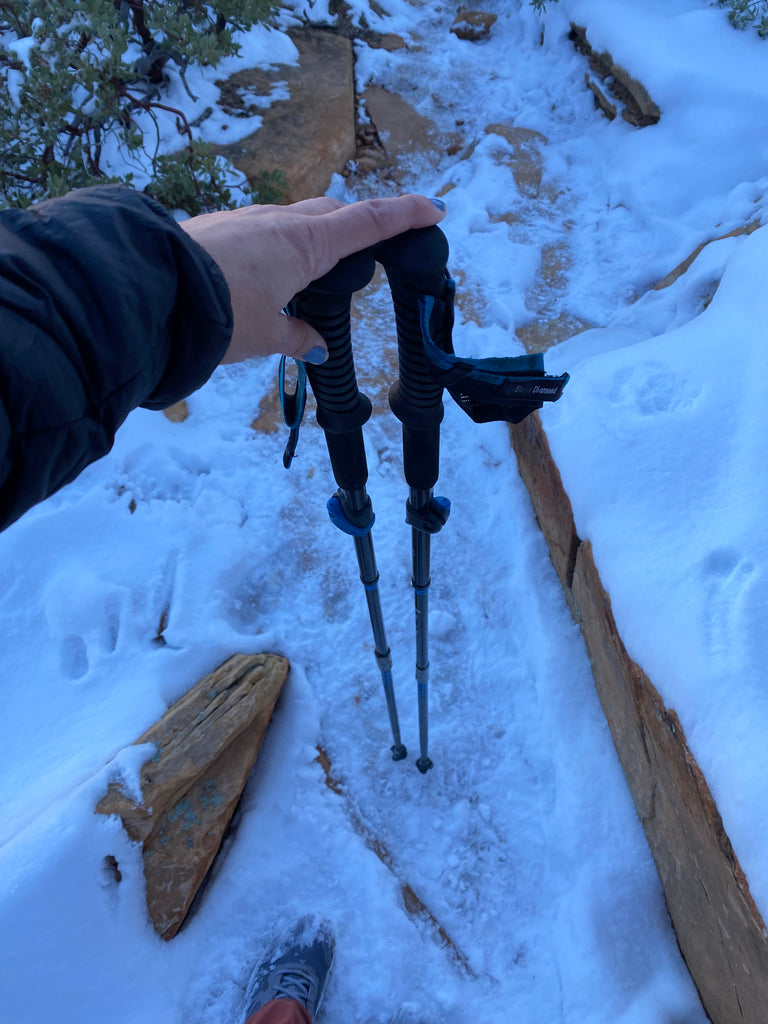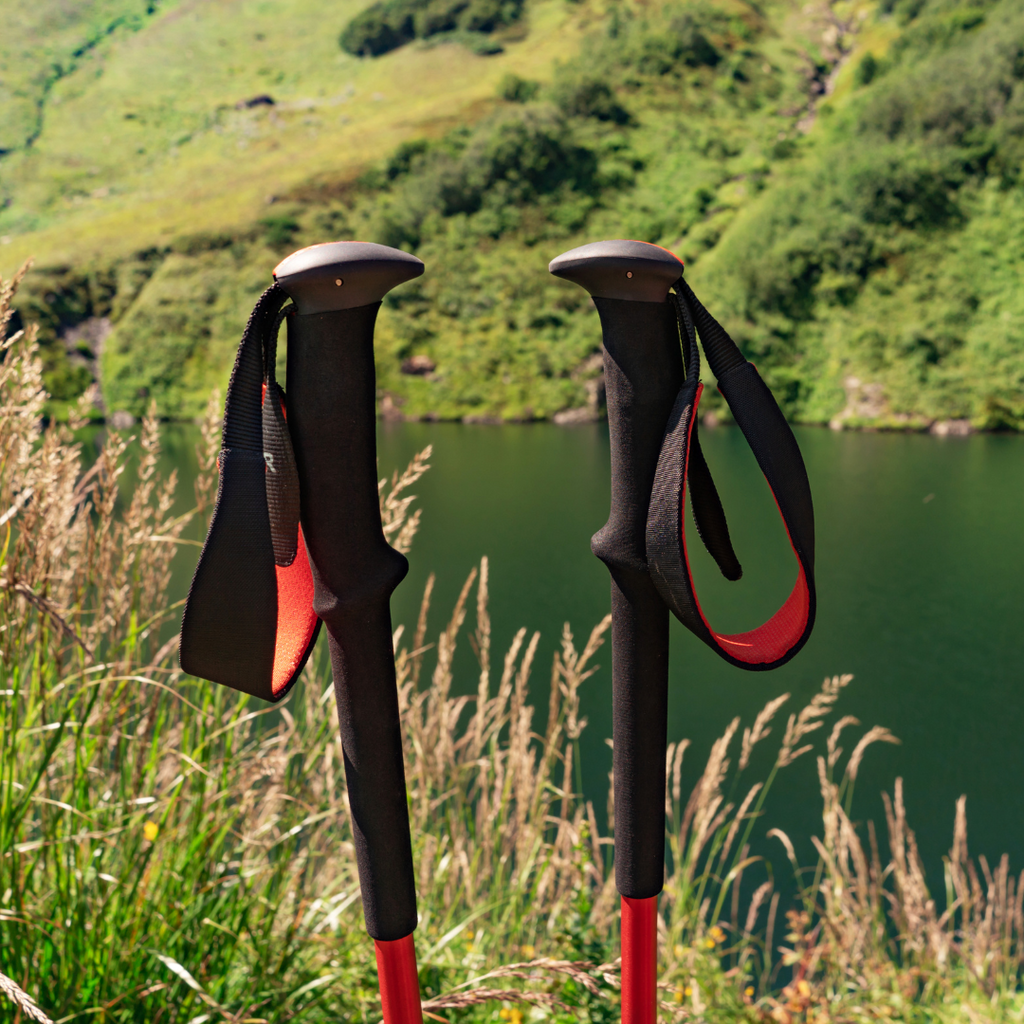
This blog includes affiliate links and is published in partnership with REI
When you’re hiking uphill, do you ever wish you had an extra boost? Do your knees ever hurt when you’re going down the mountain? Do you want to transform your 52 hikes into a full body workout?
If the answer is yes to any of these questions, trekking poles are a great gear investment for you.
If you don’t have any experience with trekking poles or if you’re curious to learn more about their significance, you’ll find out everything you need to know in our latest hiking blog.
Get ready to learn…
- What trekking poles are
- Who can benefit from trekking poles
- How to use trekking poles for hiking
- The many types of trekking poles
- Trekking pole gear recommendations
Whether you want to get your arms involved in your 52 hikes or if you’re in need of a little more support for your lower body, trekking poles will be a friend to you.
First let’s define what trekking poles are and the benefits of using them.
What Are Trekking Poles?

Go the extra mile with trekking poles. Sold as a set and used together, these trusty trail companions come in handy during all kinds of hikes. Trekking poles are essentially extensions of your arms, adding two additional points of contact with the earth. From beginner to advanced and while traveling up or downhill, trekking poles can add extra support and increase comfort while on the trail.
The main parts of trekking poles and what they’re made of:
- Tips: These stake-like pieces of your poles ensure a good grip on the ground. Made of carbide or steel, the tips are responsible for keeping you secure while in motion.
- Shaft: The shaft is the pole itself and is typically made of aluminum (more economical) or composite or carbon fibre (lighter weight). Most shafts have adjustable lengths with locking mechanisms to fit your needs.
- Internal Springs: If you want a set of trekking poles that provides shock absorption, look for internal springs in the product description.
- Grips: Constructed with grooves to fit your hands and fingers, the grips are your trekking pole handles. They come in cork (moisture resistant), foam (softest) and rubber (provides insulation & shock absorption).
- Wrist Straps: The straps secure your poles to your hands and support your wrists as you move with your poles. Most straps have adjustable lengths to fit you.
Pro Tip for Your Pole Tip: Extend the life of your pole tip (pun intendend) by using rubber tip protectors when your poles are not in use.
Pro Tip for Your Photography Game: Some trekking poles come with camera mounts so you can document your adventure while in motion.
In a nutshell, a trekking pole is a hiking stick made with intention. Keep reading to hear why you’ll benefit from using trekking poles.
The Benefits of Trekking Poles

The truth is everyone can benefit from trekking poles. Beginner, advanced, injured, disabled and senior hikers can all find support from using this piece of hiking gear.
Trekking poles help you…
- Balance on uneven terrain
- Increase your stability on the trail and for river crossings
- Absorb impact during downhill travel
- Sit and stand with ease, especially while wearing a heavy pack
- Take pressure off your back, core and lower body
- Add an upper body workout to your hiking adventures
- Enhance your endurance while on long, hard hikes
In addition to these main benefits, trekking poles can serve as on-trail tools to measure water depths, stake a shelter, provide emergency medical care and much more.
Hear from Karla Amador, founder of 52 Hike Challenge, on how trekking poles can serve you on your hiking adventures:
“The reason I recommend poles is because they can help support you, especially when going downhill or crossing streams and rivers. They can help to keep you stable when you have a large pack on too. There have been many times where trekking poles have helped me to stop a fall. But poles can do much more, like tell the depth of a stream and nowadays they even help to hold one's tent up! Trekking poles can also help to get bushes out of the way when in an overgrown area. There is also a study that claims trekking poles help to take strain off your knees.” – Karla Amador, Founder of 52 Hike Challenge
Now that you know why trekking poles are such a helpful piece of hiking gear, let’s dive into how to use trekking poles for hiking.
How to Use Trekking Poles for Hiking

It’s time to learn how to hit the trail with trekking poles. As you now know, trekking poles are a set of hiking gear that will help you traverse the trail even more easily.
Typically, you will use two poles in tandem. While one pole acts as a fancy hiking stick, two poles equally distribute weight and provide more support while hiking.
How trekking poles work is pretty intuitive: Just like you put one foot in front of the other, you also put one pole in front of the other.
First, you will want to measure the length of your poles to ensure they fit your body. As a rule of thumb, you should adjust your poles so your elbows can bend at a 90-degree angle while holding them with the tips meeting the ground.
Then, tighten the wrist straps so that you feel supported while gripping the poles. This will help keep your hands relaxed while hiking.
As you hike with trekking poles, allow the tips to dig slightly into the earth to provide traction as you move. Maintain a gentle grip on the poles as you trek, and keep your elbows close to your body.
When maneuvering up a steep hill or over a boulder, you may want to use both poles parallel to each other to help hoist yourself up.
While not in motion of passing over hard terrain, it is a good idea to place rubber protectors on your pole tips.
Pro Tip for the Environment: Remember to Leave No Trace while using your trekking poles. Don’t use your poles to move rocks or carve into trees.
Types of Trekking Poles

There are many types of trekking poles, and the right pair for you will depend on your needs.
- Traditional trekking poles with shock support: People with sensitive knees or back pain will benefit from trekking poles with shock absorption as this style of pole reduces impact on your body.
- Ultralight trekking poles: Especially useful for backpackers, ultralight poles allow you to get all the great benefits of trekking poles without adding a lot of extra weight to your pack.
- Collapsible trekking poles: These are a great option for those who want more room in their pack and for folks who only use poles during certain parts of their hikes.
Which trekking poles are you going with? If you need some help deciding, you’ll find a few options for our favorite trekking poles in the next section below.
Gear Recommendations: The Best Trekking Poles for Hiking

When looking for the best trekking poles for hiking, we recommend something packable and adjustable that works on lots of terrain. Find our top recommendations for trekking poles at REI:
Get More Gear Tips for Your 52 Hike Challenge
Do you want even more hiking tips from our founder, Karla? Sign up for the 52 Hike Challenge Hiking 101 Course where you will learn all about hiking gear, hike planning and much, much more.
